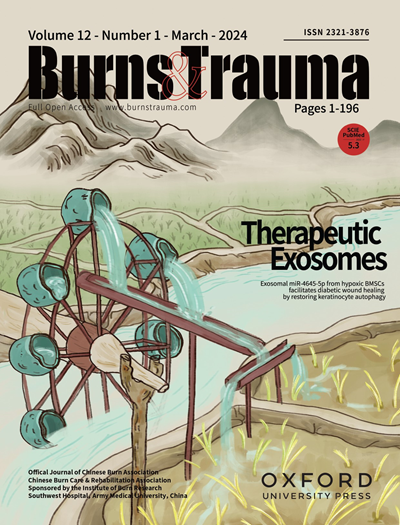2010年至2020年美国急诊科下肢骨科损伤的种族差异
IF 6.3
1区 医学
Q1 DERMATOLOGY
引用次数: 0
摘要
种族和民族差异仍然是骨科手术的主要问题,导致资源分配不公平,临床结果不同,医疗成本增加。本研究的目的是调查过去10年来美国骨科下肢创伤(LET)发病率和损伤模式的潜在种族/民族差异,以及最终处置结果的差异。在国家电子伤害监测系统数据库中查询了2010年至2020年在美国急诊科出现的所有骨科LET。发病率比(IRR)用于比较不同种族/族裔群体之间的发病率。采用多变量逻辑回归比较处置结果。在分析的10年期间,黑人/非裔美国人(Black/AAs)的LET发病率始终最高(709.108 / 100000人年),其次是白人(547.159 / 100000人年)。此外,黑人/黑人的多发伤发生率最高(每10万人年114.19例),比白人高1.7倍以上(IRR: 1.73[95%可信区间(CI): 1.72-1.75])。与白人相比,黑人/AAs在LET后死亡的几率高出2倍以上(调整后的优势比[aOR] 2.15 [95% CI: 1.78-2.59])。到2019年至2020年,黑人/AAs的死亡率达到白人的三倍以上(IRR: 3.50 [95% CI: 2.74-4.46])。黑/AAs患者也最有可能违背医嘱出院(aOR: 1.94 [95% CI: 1.92-1.96]),最不可能住院(aOR: 0.683 [95% CI: 0.679-0.688])。尽管与白人相比,黑人/AAs经历了不成比例的更高的LET发病率和超过2倍的死亡几率,但他们也是最可能出院的AMA和最不可能住院的患者。了解有意识/无意识偏见的影响,以及有效沟通和患者教育的重要性,可以帮助医生确保这类患者群体中的损伤不会过早出院,从而潜在地改善临床结果,降低死亡率。3本文章由计算机程序翻译,如有差异,请以英文原文为准。
Racial disparities in lower extremity orthopaedic injuries presenting to U.S. emergency departments from 2010 to 2020
Racial and ethnic disparities remain a major problem in orthopedic surgery, driving inequitable resource distribution, disparate clinical outcomes, and increased healthcare costs. The objective of this study was to investigate potential racial/ethnic disparities in the incidence and injury patterns of orthopedic lower extremity trauma (LET) in the United States over the past 10 years, as well as differences in final disposition outcomes. The National Electronic Injury Surveillance System database was queried for all orthopedic LET presenting to U.S. emergency departments from 2010 to 2020. Incidence rate ratios (IRR) were used to compare incidence rates between racial/ethnic groups. Multivariate logistic regression was performed to compare disposition outcomes. Black/African Americans (Black/AAs) consistently experienced the highest incidence of LET over the 10-year period analyzed (709.108 per 100,000 person-years), followed by Whites (547.159 per 100,000 person-years). Furthermore, Black/AAs had the highest incidence of polytrauma (114.19 per 100,000 person-years), over 1.7x greater than Whites (IRR: 1.73 [95% confidence interval (CI): 1.72–1.75]). Black/AAs had over 2-fold higher odds of death after LET compared to Whites (adjusted odds ratio [aOR] 2.15 [95% CI: 1.78–2.59]). By 2019 to 2020, the incidence of deaths among Black/AAs reached more than triple that of Whites (IRR: 3.50 [95% CI: 2.74–4.46]). Black/AAs were also the most likely to be discharged against medical advice (AMA) (aOR: 1.94 [95% CI: 1.92–1.96]), and the least likely to be admitted as inpatients (aOR: 0.683 [95% CI: 0.679–0.688]). Despite Black/AAs experiencing a disproportionately higher incidence of LET and over 2-fold greater odds of death compared to Whites, they were also the most likely to be discharged AMA and least likely to be admitted as inpatients. Understanding the effects of conscious/unconscious biases and the importance of effective communication and patient education may help physicians ensure that injuries in this patient population are not prematurely discharged, potentially improving clinical outcomes, and reducing mortality. III.
求助全文
通过发布文献求助,成功后即可免费获取论文全文。
去求助
来源期刊

Burns & Trauma
医学-皮肤病学
CiteScore
8.40
自引率
9.40%
发文量
186
审稿时长
6 weeks
期刊介绍:
The first open access journal in the field of burns and trauma injury in the Asia-Pacific region, Burns & Trauma publishes the latest developments in basic, clinical and translational research in the field. With a special focus on prevention, clinical treatment and basic research, the journal welcomes submissions in various aspects of biomaterials, tissue engineering, stem cells, critical care, immunobiology, skin transplantation, and the prevention and regeneration of burns and trauma injuries. With an expert Editorial Board and a team of dedicated scientific editors, the journal enjoys a large readership and is supported by Southwest Hospital, which covers authors'' article processing charges.
 求助内容:
求助内容: 应助结果提醒方式:
应助结果提醒方式:


